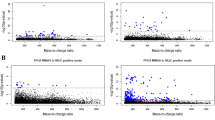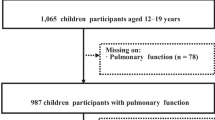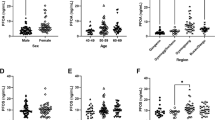Abstract
Per- and polyfluoroalkyl substances (PFAS), synthetic organic chemicals, have been discovered in the blood of both humans and animals throughout the world. This has raised widespread concerns about its toxicity, especially for growing children and adolescents. Most research on growth and development to date has concentrated on children at birth and during the first two years, while few studies have analyzed weight, height, and Body Mass Index (BMI) changes in children later in life. The present study aims to assess the association between serum PFAS levels and growth and development in adolescents. Through multiple linear regression, we explored the relationship between serum PFAS levels and weight, height, and BMI in adolescents (aged 12 to 19 years) participating in the 2015–2018 National Health and Nutrition Examination Survey (NHANES). After covariate adjustment, serum perfluorooctane sulfonic acid (PFOS) was associated with decreased weight-for-age z-score in females (tertile 2 of PFOS: β = − 0.22, 95% CI: -0.68, 0.23; tertile 3 of PFOS: β = − 0.78, 95% CI: -1.20, − 0.36; P for trend = 0.009), while serum perfluorononanoic acid (PFNA) was associated with decreased weight-for-age z-score in males (tertile 2 of PFNA: β = 0.09, 95% CI: -0.40, 0.58; tertile 3 of PFNA: β = − 0.44, 95% CI: -0.86, − 0.03; P for trend = 0.018).In addition, serum PFOS was associated with decreased BMI z-score in all participants (tertile 2 of PFOS: β = − 0.15, 95% CI: -0.46, 0.16; tertile 3 of PFOS: β = − 0.63, 95% CI: -1.06, − 0.20; P for trend = 0.013).
Conclusion: Our findings indicate a negative association between serum PFAS levels and weight, and BMI among adolescents, and we observed that the negative association was sex-specific in weight.
What is Known: • Wide exposure to PFAS has led to concerns about its adverse effects, especially for children during their growth and development. • So far, much research has evaluated the effects of prenatal PFAS exposures on children, and the current results are mixed, with some research showing that there are sex differences. | |
What is New: • This study investigated the relationship between serum PFAS levels and height and weight in adolescents and is a good addition to current research. • Our study found that exposure to PFAS negatively affects adolescent growth and development and that this effect is sex-specific. |

Similar content being viewed by others
Data availability
Data will be made available on request.
References
Langenbach B, Wilson M (2021) Per- and Polyfluoroalkyl Substances (PFAS): Significance and Considerations within the Regulatory Framework of the USA. Int J Environ Res Public Health 18:. https://doi.org/10.3390/ijerph182111142
De Silva AO, Armitage JM, Bruton TA et al (2021) PFAS Exposure Pathways for Humans and Wildlife: A Synthesis of Current Knowledge and Key Gaps in Understanding. Environ Toxicol Chem 40:631–657. https://doi.org/10.1002/etc.4935
Lewis RC, Johns LE, Meeker JD (2015) Serum Biomarkers of Exposure to Perfluoroalkyl Substances in Relation to Serum Testosterone and Measures of Thyroid Function among Adults and Adolescents from NHANES 2011–2012. Int J Environ Res Public Health 12:6098–6114. https://doi.org/10.3390/ijerph120606098
(2022) Agency for Toxic Substances and Disease Registry. https://www.atsdr.cdc.gov/index.html. Accessed 12 Nov 2022
Lee YJ, Jung HW, Kim HY, et al (2021) Early-Life Exposure to Per- and Poly-Fluorinated Alkyl Substances and Growth, Adiposity, and Puberty in Children: A Systematic Review. Front Endocrinol 12:683297. https://doi.org/10.3389/fendo.2021.683297
Shoaff J, Papandonatos GD, Calafat AM, et al (2018) Prenatal Exposure to Perfluoroalkyl Substances: Infant Birth Weight and Early Life Growth. Environ Epidemiol Phila Pa 2:e010. https://doi.org/10.1097/EE9.0000000000000010
Braun JM, Eliot M, Papandonatos GD et al (2005) (2021) Gestational perfluoroalkyl substance exposure and body mass index trajectories over the first 12 years of life. Int J Obes 45:25–35. https://doi.org/10.1038/s41366-020-00717-x
Gyllenhammar I, Diderholm B, Gustafsson J et al (2018) Perfluoroalkyl acid levels in first-time mothers in relation to offspring weight gain and growth. Environ Int 111:191–199. https://doi.org/10.1016/j.envint.2017.12.002
Negri E, Metruccio F, Guercio V et al (2017) Exposure to PFOA and PFOS and fetal growth: a critical merging of toxicological and epidemiological data. Crit Rev Toxicol 47:482–508. https://doi.org/10.1080/10408444.2016.1271972
Cao W, Liu X, Liu X et al (2018) Perfluoroalkyl substances in umbilical cord serum and gestational and postnatal growth in a Chinese birth cohort. Environ Int 116:197–205. https://doi.org/10.1016/j.envint.2018.04.015
Chen M-H, Ng S, Hsieh C-J et al (2017) The impact of prenatal perfluoroalkyl substances exposure on neonatal and child growth. Sci Total Environ 607–608:669–675. https://doi.org/10.1016/j.scitotenv.2017.06.273
Lee YA, Kim JH, Jung HW et al (2018) The serum concentrations of perfluoroalkyl compounds were inversely associated with growth parameters in 2-year old children. Sci Total Environ 628–629:226–232. https://doi.org/10.1016/j.scitotenv.2018.02.050
Wang Y, Adgent M, Su P-H et al (2016) Prenatal Exposure to Perfluorocarboxylic Acids (PFCAs) and Fetal and Postnatal Growth in the Taiwan Maternal and Infant Cohort Study. Environ Health Perspect 124:1794–1800. https://doi.org/10.1289/ehp.1509998
Scinicariello F, Buser MC, Abadin HG, Attanasio R (2020) Perfluoroalkyl substances and anthropomorphic measures in children (ages 3–11 years), NHANES 2013–2014. Environ Res 186:109518. https://doi.org/10.1016/j.envres.2020.109518
(2022) NHANES - National Health and Nutrition Examination Survey Homepage. https://www.cdc.gov/nchs/nhanes/index.htm. Accessed 12 Nov 2022
Ye X, Kato K, Wong L-Y et al (2018) Per- and polyfluoroalkyl substances in sera from children 3 to 11 years of age participating in the National Health and Nutrition Examination Survey 2013–2014. Int J Hyg Environ Health 221:9–16. https://doi.org/10.1016/j.ijheh.2017.09.011
Jackson-Browne MS, Eliot M, Patti M, et al (2020) PFAS (per- and polyfluoroalkyl substances) and asthma in young children: NHANES 2013–2014. Int J Hyg Environ Health 229:113565. https://doi.org/10.1016/j.ijheh.2020.113565
Kuczmarski RJ, Ogden CL, Guo SS et al (2002) 2000 CDC Growth Charts for the United States: methods and development. Vital Health Stat 11:1–190
(2019) Growth Charts - Percentile Data Files with LMS Values. https://www.cdc.gov/growthcharts/percentile_data_files.htm. Accessed 9 Dec 2022
Child Anthropometry z-Score Calculator. https://nutriverse.io/zscorer/index.html. Accessed 9 Dec 2022
Geiger SD, Yao P, Vaughn MG, Qian Z (2021) PFAS exposure and overweight/obesity among children in a nationally representative sample. Chemosphere 268:128852. https://doi.org/10.1016/j.chemosphere.2020.128852
Janis JA, Rifas-Shiman SL, Seshasayee SM, et al (2021) Plasma Concentrations of Per- and Polyfluoroalkyl Substances and Body Composition From Mid-Childhood to Early Adolescence. J Clin Endocrinol Metab 106:e3760–e3770.
Sevelsted A, Gürdeniz G, Rago D, et al (2022) Effect of perfluoroalkyl exposure in pregnancy and infancy on intrauterine and childhood growth and anthropometry. Sub study from COPSAC2010 birth cohort. eBioMedicine 83:104236. https://doi.org/10.1016/j.ebiom.2022.104236
(2022) R Core Team (2022). R: A language and environment for statistical computing. R Foundation for Statistical Computing, Vienna, Austria: 4.2.2. URL https://www.R-project.org/.
NHANES Tutorials - Module 1 - Datasets and Documentation. https://wwwn.cdc.gov/nchs/nhanes/tutorials/module1.aspx. Accessed 13 Nov 2022
Fassler CS, Pinney SE, Xie C, et al (2019) Complex relationships between perfluorooctanoate, body mass index, insulin resistance and serum lipids in young girls. Environ Res 176:108558. https://doi.org/10.1016/j.envres.2019.108558
Sm P, Gc W, C X, et al (2019) Perfluorooctanoate and changes in anthropometric parameters with age in young girls in the Greater Cincinnati and San Francisco Bay Area. Int J Hyg Environ Health 222:. https://doi.org/10.1016/j.ijheh.2019.07.002
Gao Y, Luo J, Zhang Y, et al (2022) Prenatal Exposure to Per- and Polyfluoroalkyl Substances and Child Growth Trajectories in the First Two Years. Environ Health Perspect 130:037006. https://doi.org/10.1289/EHP9875
Starling AP, Adgate JL, Hamman RF, et al (2019) Prenatal exposure to per- and polyfluoroalkyl substances and infant growth and adiposity: the Healthy Start Study. Environ Int 131:104983. https://doi.org/10.1016/j.envint.2019.104983
Andersen CS, Fei C, Gamborg M et al (2010) Prenatal exposures to perfluorinated chemicals and anthropometric measures in infancy. Am J Epidemiol 172:1230–1237. https://doi.org/10.1093/aje/kwq289
Hartman TJ, Calafat AM, Holmes AK et al (2017) Prenatal Exposure to Perfluoroalkyl Substances and Body Fatness in Girls. Child Obes Print 13:222–230. https://doi.org/10.1089/chi.2016.0126
Canova C, Di Nisio A, Barbieri G et al (2021) PFAS Concentrations and Cardiometabolic Traits in Highly Exposed Children and Adolescents. Int J Environ Res Public Health 18:12881. https://doi.org/10.3390/ijerph182412881
Yu W-G, Liu W, Jin Y-H (2009) Effects of perfluorooctane sulfonate on rat thyroid hormone biosynthesis and metabolism. Environ Toxicol Chem 28:990–996. https://doi.org/10.1897/08-345.1
Song M, Kim Y-J, Park Y-K, Ryu J-C (2012) Changes in thyroid peroxidase activity in response to various chemicals. J Environ Monit JEM 14:2121–2126. https://doi.org/10.1039/c2em30106g
Ren X-M, Qin W-P, Cao L-Y et al (2016) Binding interactions of perfluoroalkyl substances with thyroid hormone transport proteins and potential toxicological implications. Toxicology 366–367:32–42. https://doi.org/10.1016/j.tox.2016.08.011
Du G, Hu J, Huang Z et al (2019) Neonatal and juvenile exposure to perfluorooctanoate (PFOA) and perfluorooctane sulfonate (PFOS): Advance puberty onset and kisspeptin system disturbance in female rats. Ecotoxicol Environ Saf 167:412–421. https://doi.org/10.1016/j.ecoenv.2018.10.025
Ding N, Harlow SD, Randolph JF et al (2020) Perfluoroalkyl and polyfluoroalkyl substances (PFAS) and their effects on the ovary. Hum Reprod Update 26:724–752. https://doi.org/10.1093/humupd/dmaa018
Ye L, Guo J, Ge R-S (2014) Environmental pollutants and hydroxysteroid dehydrogenases. Vitam Horm 94:349–390. https://doi.org/10.1016/B978-0-12-800095-3.00013-4
Zhao B, Chu Y, Hardy DO et al (2010) Inhibition of 3beta- and 17beta-hydroxysteroid dehydrogenase activities in rat Leydig cells by perfluorooctane acid. J Steroid Biochem Mol Biol 118:13–17. https://doi.org/10.1016/j.jsbmb.2009.09.010
Shi Z, Zhang H, Ding L et al (2009) The effect of perfluorododecanonic acid on endocrine status, sex hormones and expression of steroidogenic genes in pubertal female rats. Reprod Toxicol Elmsford N 27:352–359. https://doi.org/10.1016/j.reprotox.2009.02.008
Author information
Authors and Affiliations
Contributions
Yi-Fan Wang: Conceptualization, Methodology, Software, Writing—original draft, Review, & Editing. Xu-Ran Zhang: Data Curation, Writing- Original draft preparation. Ying-Xue Zou: Writing- Reviewing and Editing.
Corresponding author
Ethics declarations
Ethics approval
The data used in this study were obtained from the public database National Health and Nutrition Examination Survey (NHANES), which was approved by the Ethics Review Board of the National Center for Health Statistics of the Centers for Disease Control and Prevention (CDC).
Consent to participate
All participants provided informed consent before participation.
Consent to publish
For each specific NHANES cycle, the approval protocol numbers are as follows:
NHANES 2017–2018: Protocol #2018–01 (Effective beginning October 26, 2017); Continuation of Protocol #2011–17 (Effective through October 26, 2017) NHANES 2015–2016: Continuation of Protocol #2011–17.
Competing interests
The authors declare no competing interests.
Additional information
Communicated by Peter de Winter
Publisher's Note
Springer Nature remains neutral with regard to jurisdictional claims in published maps and institutional affiliations.
Supplementary Information
Below is the link to the electronic supplementary material.
Rights and permissions
Springer Nature or its licensor (e.g. a society or other partner) holds exclusive rights to this article under a publishing agreement with the author(s) or other rightsholder(s); author self-archiving of the accepted manuscript version of this article is solely governed by the terms of such publishing agreement and applicable law.
About this article
Cite this article
Wang, YF., Zhang, XR. & Zou, YX. Serum perfluoroalkyl substances and growth and development in US adolescents: a nationally representative cross-sectional study. Eur J Pediatr 182, 4673–4681 (2023). https://doi.org/10.1007/s00431-023-05136-4
Received:
Revised:
Accepted:
Published:
Issue Date:
DOI: https://doi.org/10.1007/s00431-023-05136-4




